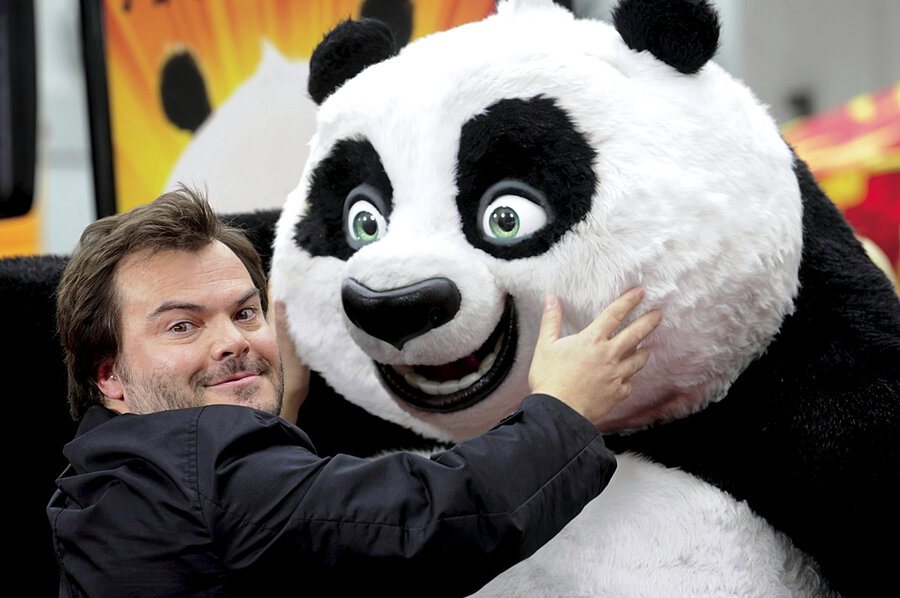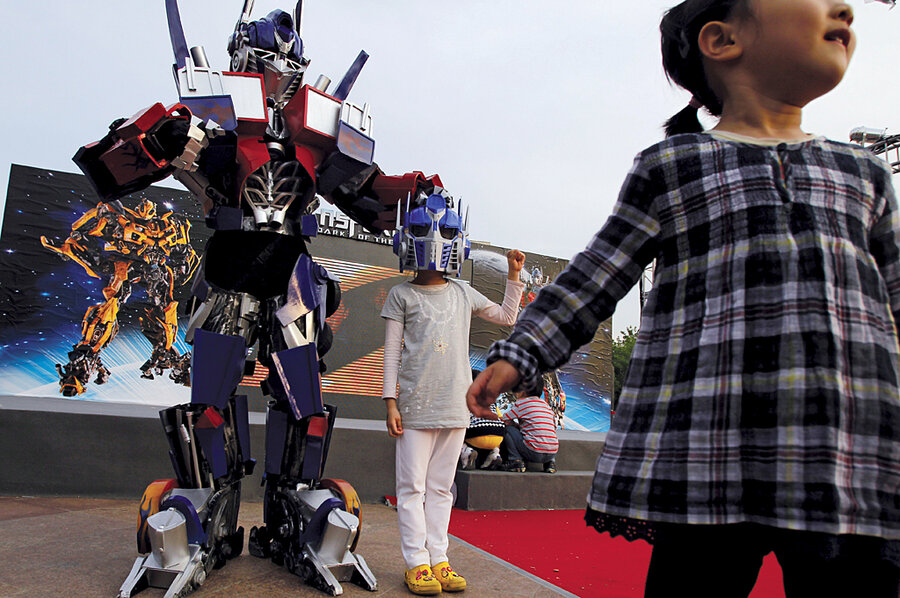Kung Fu Panda 2: Hollywood works harder to win Chinese audiences
Loading...
| Chengdu, China
A decade ago, as China closed in on membership in the World Trade Organization (WTO), key negotiators now say, it wasn't talk of opening a huge market to grain or machinery that threatened talks: It was haggling over movies, the ultimate soft-power export.
Today, Chinese consumer confidence has soared. That has lifted movie ticket sales, which jumped 64 percent in 2010 to $1.5 billion, thanks partly to a 3-D craze and a mushrooming of cinemas in China. But what's also grown is official wariness of the influence of foreign media, so much so that Beijing – a WTO member since 2001 – has all but ignored a March WTO deadline to open film distribution to greater foreign participation, and has refused to discuss the annual cap of 20 imported films.
In late May, taking a page out of China's 1972 playbook – when Beijing gave two rare black-and-white bears to Washington's National Zoo after President Nixon's historic visit – envoys from DreamWorks Animation went to Sichuan Province bearing "Kung Fu Panda 2," part of DreamWorks's effort to establish a paw-hold in the globe's fastest-growing movie market. The China Film Group (CFG) released the film nationwide on May 27, dubbed into Chinese.
Their effort drew on lessons from the release of the first "Kung Fu Panda" in China right before the 2008 Beijing Olympics. Many loved it, making it the first animated feature film here to gross more than 100 million yuan ($15 million) in ticket sales. Others said DreamWorks's take on China's ancient culture fell as flat as its 2-D portrayal.
Fast-forward three years and the stakes are higher. Tickets costing as much as 120 yuan ($18.50) helped China become the No. 2 movie market after the United States for 20th Century Fox's "Avatar." After its January 2010 release, it went on to gross more than $200 million in China. Walt Disney Pictures's "Pirates of the Caribbean 4: On Stranger Tides" recently topped the opening weekend figures for "Avatar."
Those kind of box-office numbers get the attention of US moviemakers. They ensure that the studios will increasingly take into account not only what will fly with China's middle-class audience but also with Beijing censors, who must approve every film.
Disney learns the hard way
Disney learned the hard way that media minders in Beijing watch for anything, anywhere, that questions China's unity and the supremacy of the Communist Party. In 1997, Disney, whose interests in China extend to publishing, merchandising, and theme parks, upset Beijing by releasing director Martin Scorsese's "Kundun," a film about the current Dalai Lama's exile to India after the People's Liberation Army's occupation of Tibet. Though it was never intended for release in China, insiders say Disney's initiatives in China were stalled for years afterward.
Beyond political considerations, US filmmakers are also trying to engage Chinese audiences more directly, instead of assuming that what plays well in New York will also be snapped up by filmgoers in Shanghai.
Fox International Productions recently made two Mandarin-language films that it distributed via Beijing-based partners Huayi Brothers Media. The romantic comedy "Hot Summer Days," which FIP made for $2 million, grossed roughly $22 million. FIP then got Hollywood hitmaker Doug Liman, director of "The Bourne Identity," to boost a martial-arts comedy, "The Butcher, the Chef, and the Swordsman," at the Pusan International Film Festival in South Korea last October.
Hollywood studios complain about their limited access to China. But they are also currying favor with the CFG, gatekeeper to the wallets of Chinese moviegoers. CFG sees itself as the guardian of Chinese mores. Films must contain the proper "Chinese elements" to be approved for release.
The plot of Sony's doomsday picture "2012" featured Chinese ark-builders as saviors of the story's flood victims. The overwhelmingly positive attention the film received in the state-controlled press hints at China's eagerness for Hollywood to abandon its historical vilification and fantasization of China in favor of helping it look good to the world.
No more Chinese enemies in the movies
Hollywood seems equally eager to do so. MGM recently scrubbed all references to a Chinese enemy from its upcoming remake of the 1984 cold-war-era drama "Red Dawn," digitally replacing Chinese military insignias with North Korean ones in a late edit.
Betting that China's multiplex owners, like their counterparts around the world, want as many high-earning 3-D films as possible, DreamWorks is playing one of its strong cards: attention to detail.
"3-D technology forced us to give depth to the film and show off the research we did in China so carefully this time around," says Raymond Zibach, veteran DreamWorks production designer for "Kung Fu Panda," during a three-day promotional tour to this cradle of the panda.
Before the first "Kung Fu Panda," which took five years to make, Mr. Zibach fought with DreamWorks chief executive officer Jeffrey Katzenberg for a China visit. He was told it would be too costly. Then the movie grossed $633 million worldwide. On his second request, Zibach got his trip.
In November 2008, with much of the first film's core creative crew in tow, Zibach went to Beijing; to Chengdu, in central China, to see pandas face to face; and then, outside Chengdu, to Mt. Qingcheng, a wellspring of Taoist philosophy and home to its own kung fu tradition.
"The mountain changed how we went about making the second film," says the California native, revisiting Chengdu and Mt. Qingcheng in late May, on only his second trip to China. "We absorbed its colors, its misty atmosphere, and its magic."
His group took 40,000 photos on that first trip and have incorporated inspiration from China's architecture and color palette into the sequel's computer-generated imagery. Local audiences may perk up at the Chinese characters for Mt. Qingcheng carved into rocks in digital scenery. "That's not product placement. It was just a nod of 'thank you,' " Zibach says.
Not long before Zibach and his team arrived to research the sequel, Mt. Qingcheng was a mess, its park and kung fu school closed in the wake of the magnitude-8.0 Wenchuan earthquake in May 2008, which collapsed thousands of buildings and killed some 68,000 people.
"We wanted to help in whatever way we could," Zibach says, "and I was so proud to hear from Chinese who saw the movie that they felt it was a part of them, that they'd had a hand in making it."
How a trip to China shaped Kung Fu Panda 2
DreamWorks Animation's Raymond Zibach says the first "Kung Fu Panda" film was designed from books and Internet research, but he knew he had to go to China for "Kung Fu Panda 2": "We'd fallen in love with pandas from afar and had to go see them for ourselves to get the second film right," the production designer says.
Mr. Zibach digitally "painted" the film's sets based on photographs he took in the Forbidden City – the walled North China city of Pingyao, in Chengdu (the capital of Sichuan Province) – and on Mt. Qingcheng, a center of kung fu tradition.
The character of baby Po, the panda who grows up to be the film's hero, was drawn after studying the movements of a baby panda at a Chengdu panda breeding facility.
The movements of Lord Shen, the evil peacock villain, are based on a particularly flexible and captivating kung fu master Zibach observed at Mt. Qingcheng.
Architectural and landscape details were drawn from elements such as the ceramic animal tiles found along traditional Chinese sloping roofs and from the lush green bamboo forests. Classical Chinese painting and martial arts films of the past decade – think "Hero" and "House of Flying Daggers" – also played a role in the film's "look," Zibach says.






